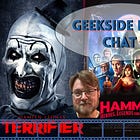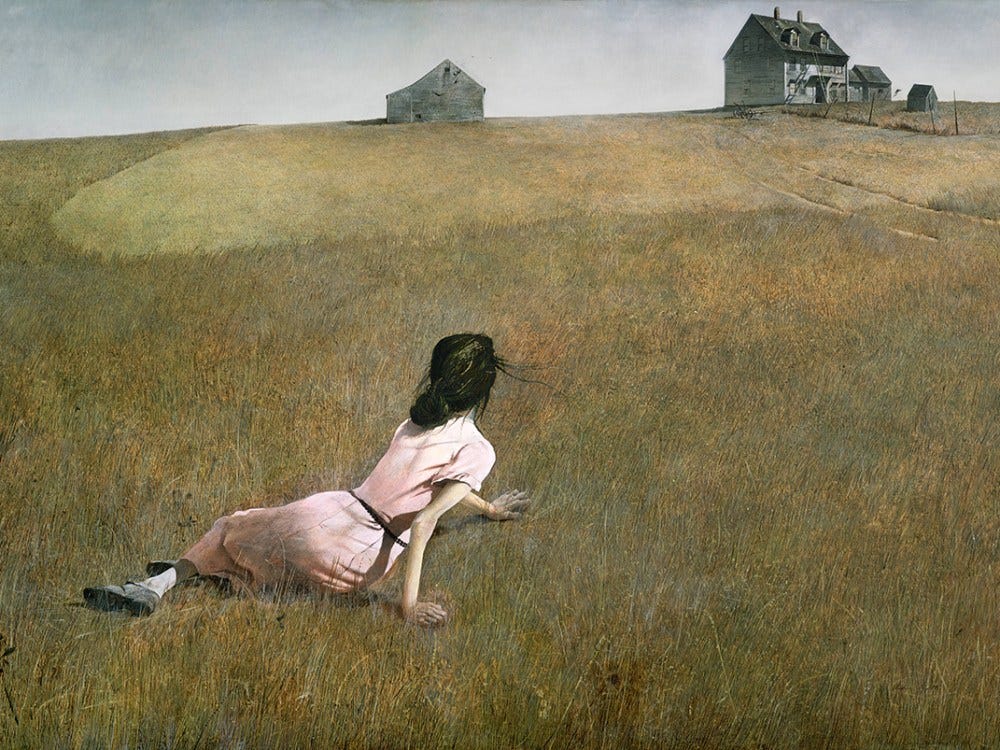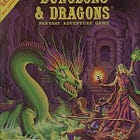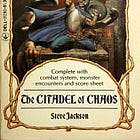What am I Geeking Out About this Week?
Weekly Geekly Rundown for 10/24/2025
Let’s Take a Moment to Remember Vincent Price
Vincent Price died from lung cancer on October 25th, 1993 and I find it somehow fitting that the man who contributed so much to the horror genre in film would die in the Spooky Season. It makes it easy to remember him and to give him a worthy tribute.
Though I did not include any Vincent Price films in my Spooky Season film recommendations in yesterday’s post, Price is my favorite actor within the genre. He made films that were serious as well as films that were pure camp, but he rarely phoned in a performance. At least, I never got the sense that he was phoning in a performance during my many viewings of his films. He, like Boris Karloff, was a tireless worker. His screen credits ranged from noir masterpieces like Otto Preminger’s Laura to the delightfully playful The Raven from Roger Corman, making him a genre fan’s dream actor.
The Raven holds a place of particular charm in my heart and I agree with Goodman Games that the movie belongs in a “cinematic” Appendix N. While the film is quirky and a bit of a slow build, The Raven has a wonderful wizard’s duel at the end that is well worth the wait. It has been argued that this duel was one of the inspirations for the magic system in the Dungeons & Dragons role playing game. We all know that Jack Vance’s Dying Earth was a major influence but if you’ve ever wondered why the Shield spell stops Magic Missile you’ll want to watch this duel.
I cannot remember what was the first Vincent Price film I ever watched. It could have been The Great Mouse Detective or The Pit and the Pendulum. What I do remember is that from the first moment I heart him speak, I was entranced. His smooth articulation made likable characters endearing and villainous characters likable. His performance as Richelieu in George Sidney’s The Three Musketeers is so charming and charismatic that you almost root for him to defeat D’Artagnan. Given how much I adore Gene Kelly in general, I find myself surprised that I just wrote that but it’s true. That’s how compelling Price is in the role.
My wife, Jody, shares my love of all things Vincent Price. His horror films are among the short list horror films she likes and she she likes him so much that she did a tribute to him in an old Nicnup cartoon. I apologize for the fact that the scan that I have uses Comic Sans, you can see from the last panel that she did hand letter the original cartoon. I am the one who made that change, to be able to clearly read all the text, which I now realize I could have just provided below the strip as I’ve done here.
We miss you Mr. Price. Thank you for all the great films.
The Lamentations of Luke Y. Thompson
Luke (aka
) kicks things off with a review of two reviews of NECA Art the Clown action figures. He promised he’d review the figures in our recent Geekside Film Chat and his reviews are very thorough. I’m particularly interested in NECA’s recent line of Ben Cooper Halloween Costume inspired action figures. At ComicCon this year, Luke shared photos of some Ben Cooper D&D Action Figures and I was really impressed.For those who aren’t familiar with the old Ben Cooper costumes of the 70s, 80s, and 90s they were an interesting phenomena. They included masks depicting a character from a pop culture property, a mildly creepy mask but usually a good rendition, matched with a body suit that featured an illustration of the character as well as the character’s name. A “Superman” Ben Cooper costume would have a mask that looked like a horror movie version of Christopher Reeve and a body suit with a still from the 1982 DC Comics Style Guide with gorgeous art by Jose Luis Garca-Lopez and the word SUPERMAN emblazened above the picture. Near as I can tell the costumes were designed by someone whose children had been asked one too many times “who they were dressed up as for Halloween.”
I stand strongly aside Luke as one of the two defender’s of Chloe Zhao’s highly underappreciated superhero film Marvel’s Eternals. I question the studio heads for thinking that The Eternals were the right property to bring into the Marvel Cinematic Universe, especially given how awkward their own introduction into the Comic Book Universe-616 was. It’s arguable whether the initial run of The Eternals took place in 616 at all and they weren’t actually brought into the timeline until a pretty bizarre, but very good, Thor storyline brought them in. Having a storyline where a secret band of space aliens helped create life on Earth and then served as the inspiration for all the Gods of myth is a great story, and the basis for the “non-fiction” book Chariots of the Gods, but it is out of place in a setting where those Gods actually walk the Earth. It’s kind of odd to see someone say “I am the inspiration for the myth of Hercules” when the Prince of Power can “Bestow the Gift” on him in response. That aside, Zhao’s film is beautiful to watch and draws heavily from the cinematography of Days of Heaven and by extension the paintings of Andrew Wyeth, and in particular his painting Christina’s World.
Narratively the film suffers from many of the problems of the comic book counterparts, but Zhao presents a compelling version of one of Marvel’s least popular and more obscure teams. When early Marvel dipped into the “obscure” to make Blade, they made a good choice. When they selected The Eternals, they made a bad one, but they hired the right director to make it work.
All of this is preamble to the fact that Luke has reviewed Zhao’s latest film Hamnet, which is a pseudo-historical drama centered on the life of Agnes and Shakespeare with added paganism and curses and meloncholy. Based on Luke’s review, more than the others I’ve read, I really want to watch this film. One of the things being a parent has taught me is that parenting comes with a new constant emotional state, a dull humming of dread that never goes away. That dread represents the worry that something bad might happen to your children. It’s not fear, though there are moments of that like the first time your daughter walks down the stairs herself, it’s background noise. It’s the soundtrack to a horror movie that might never give you a jump scare. There is no catharsis from it because it never goes away. There is no point where worry ends. The movie Parenthood gets that, and so much more, exactly right. This isn’t to say that parenting is filled with dread, as I said it’s background noise. Parenting is a wonderful and beautiful symphony filled with major chords and highs and lows that are more than worth the worry, but that worry is a constant companion and to see a film that engages with that hum becoming the melody very much sounds worth it.
In a recent post
investigates and reviews an older made for television, by Hallmark no less, fantasy miniseries called The 10th Kingdom. The miniseries has a very interesting cast, including Diane Wiest (who was magnificent in Parenthood), and a storyline that has since become a bit cliche but wasn’t at the time. What struck me as most interesting about the series was that it was written by Simon Moore who wrote one of my favorite modern Westerns, Sam Raimi’s The Quick and the Dead. I haven’t seen the series, but I’ve added it to my list. reviews Kathryn Bigelow’s latest film A House of Dynamite which is the kind of film I hadn’t expected to see again in my lifetime, but which tells us a great deal about the fears lurking in the zeitgeist. When I was young, I watched Dreamscape, The Dead Zone, Threads, The Day After, and Testament. I still can’t watch The West Wing without imagining the moment in The Dead Zone is the series finale. What all of these films share is a dread of a potential nuclear holocaust. Of them, Threads and Testament hit the hardest and most realistic and are thus both terrifying.As I got older though, the films lost a bit of that terror as my own internal Doomsday Clock was set to 6:30 and the real use of nuclear weapons seemed a distant thing. After the fall of the Berlin Wall, it became hard to believe that conflict between the US and (now) Russia could come to that kind of outcome and rogue actors were just that. Yet here we are, in a world where one of the most talented action film directors of our generation (Point Break, Near Dark, and Strange Days are a deep enough resume without getting to the “serious” films) is making a film about a nuclear strike and our reaction to it…and it’s a serious movie not a spoof. While my personal Doomsday Clock is still far from Midnight, it looks to be close enough for others and David’s review has given me some good reasons to watch Bigelow’s latest.
In her lates “Horror Moments,” Dr.
continues her exploration of the works of Edward Gorey with a discussion of The Hapless Child. It’s a tale of tragedy, separation, and loss (hmm…is that today’s theme?) that hits very hard, but it also got me thinking about where Gorey might have found some inspiration (outside of Dickens that is).The Hapless Child was published in 1961 which is a couple of years after Samuel Hopkins Adams book Tenderloin (1959) was published. Tenderloin was about the battle to end Tammany Hall in New York and the book was adapted into the musical Tenderloin in 1960. The musical modified the events of the novel significantly, as happens, and it featured a beautiful song called Artificial Flowers (read Dr. King’s discussion and you’ll see why that’s an important connection). The song hit #20 in the Billboard Top 40 with the recording by crooner extraordaire Bobby Darin. The song makes a nice companion piece to the Gorey tale, because it’s a song that has an ending just as sad as The Hapless Child. Given that Gorey was living in Manhattan at the time the musical was in performance, and in the United States when the song came out, I cannot help but wonder if he was a little inspired by the song when he wrote The Hapless Child. The stories are different enough that it would be slander to accuse him of plagiarism, but there are some significant thematic similarities.
I’m a big fan of JP Coovert’s work as a role playing game creator, so I really enjoyed reading
’s review of Dragontown and the Darkness Below. Alex played the game with his kiddos, which is one of the great joys of parenthood. I remember when I first played Tails of Equestria: The My Little Pony Role Playing Game with my daughters and that led to a lifetime of me playing games with History and Mystery, including our current Dragonlance campaign. Tails of Equestria was designed by Alessio Cavatore, the man behind Mordheim, and he managed to bring complexity to a very simple system. From Alex’s review, it looks like Coovert did equally well with his Dragontown set. Oh, and Coovert is currently working to create his own “perfect” role playing game so you might check out his Patreon (which I pronounce Pay-treon because Patron is pronounced Pay-tron). reminds us that not only was the creator of Mary Poppins horrified by what Walt Disney did to her character, but Mary Poppins herself was very rough around the edges. Not a lot of sugar and spice, well maybe a lot of spice, from the literary nanny. As much as I love Disney films in general, I think that Walt did us a disservice when he tried to make the nanny cheerful and bright. I think a more sarcastic and strict character would be a welcome addition on the screen, and certainly was what the family actually needed with those kids. The parents were what people in psychology tend to refer to as “permissive parents” and let’s just say that their children tend to have a rough go at life. So too do the children of “authoritarian parents,” but Mary is an “authoritative” pedagogue and that is what is called for.So…you’ve got a hunch? Should you relie on it, or should you run 14 hours of Bayesian Regression Analysis to determine whether you should follow it?
engages with that question and how psychologists analyze that conflict, which in some ways is not a conflict at all, but I’ll leave that discovery for the reading. Though, you might have a hunch as to what the answer is. had jumped on the “sharing older stories” bandwagon and I’m all in. We spen a lot of time trying to find new and exciting things, but sometimes the freshest ideas were already written and have become overlooked. One of my mentoring professors (Martin Johnson who sadly died far too young) used to tell us that if we wanted to ask fresh questions in political science for our research, then we should look to the older classics. People have forgotten them and we have new methods to test their findings, the same is true with literature and that’s why I love seeing people share older tales as well as new.Last, but certainly not least, is
’s discussion of The Warlock of Firetop Mountain. The book was the first “gamebook” ever published, as a gamebook that is as Rick Loomis’ Buffalo Castle was the first solo module, and it holds a special place in my heart. I’ve mentioned in the past how my first D&D experience was terrible and how my first real roleplaying experience was playing the Fighting Fantasy Gamebooks, so I was very interested in seeing how a modern solo gamer would feel after revisiting one of the first publications in that genre. It turns out that it was a pretty good experience, if a bit rough around the edges. It got me to revisit the book myself, and I agree with Paul’s assessment. I am also glad that I got the new Steve Jackson Games versions of the first 5 gamebooks. Oh, there’s an interesting story there because Steve Jackson (US) isn’t the Steve Jackson (UK) who co-founded Games Workshop and wrote half of The Warlock of Firetop Mountain, but he did write one entry in the series.Introduction
In his introduction to his collection of essays The Film, Andrew Sarris writes that “Vachel Lindsay’s major contribution to film aesthetics consisted of distinguishing the artistic ends best suited to the differing expressive means of the stage play and the photoplay.” It may seem odd to begin a game recommendation with a quote from a collection of film criticism, but it isn’t when the game being discussed is My Life with Master by Paul Czege.
Paul was a very active participant in a particular indie gaming subculture of designers who once gathered at The Forge. This group was aggressively pursuing the philosophy and psychology of roleplaying games as a form of play as well as attempting to create useful analytical taxonomies. This group of game theorists and designers often stressed the value of roleplaying games as art as opposed to as mere pastimes. In particular, they usually discussed roleplaying games in the framework of the narrative art form. Unlike the shamanistic and Jungian approach of earlier designers like Greg Stafford who focused on role playing games as ritualistic art, the designers at The Forge rooted their analysis in post-structuralist and other more modern frameworks.
One major source of inspiration, though certainly not the source of inspiration, for participants in The Forge movement was Greg Costikyan’s game theory manifesto “I Have No Words and I Must Design.” The essay was originally published in the second issue of the short lived procademic (pro/academic) publication Inter*Action/Interactive Fantasy and an updated version of the essay is available for free at Greg’s website. I’d recommend getting both as Interactive Fantasy is a highly underrated glimpse at late 90s game designers that provides context to a lot of what is happening in the industry today not that the authors are now in significant leadership roles.
In the original essay, Costikyan writes that “A game is a form of art in which participants, termed players, make decisions in order to manage resources through game tokens in the pursuit of a goal.” While we might debate the merits of this definition of game noun by noun, it is important to note that Costikyan is emphasizing games as a form of art. For many in the community that made up The Forge, role playing games would best be described as a form of narrative art.
It is all well and good for a critic, or theorist, to talk of a particular entertainment medium as art, not artifice which by definition includes all man made things, but Art, it is quite another to apply such criticism/theory to the medium in question. Yet that is exactly what the community at The Forge did on a frequent basis. Quite a large number of excellent, well thought out, and interesting games have grown out of The Forge’s fertile intellectual soil. My Life with Master is one of those games.
Theme
My Life with Master is a game in which the players create a narrative simulating romantic/gothic horror like that of Nosferatu, Dracula or Frankenstein. The players take on the role of minions of a twisted master. They are the Knocks, Igors, and Renfields to the game master’s Count Orlok, Victor Frankenstein, or Dracula. As the author Paul Czege describes the theme, My Life with Master is “a roleplaying game about the horrific and dysfunctional ties that bind a monstrous Master and his or her minions.”
Think about how Knock interacts with Thomas and what that costs him mentally or a grounded and complex presentation of Renfield and you’ve got a good idea of what My Life with Master is aiming at.
Throughout the play of the game, the game master in the role of the Master will give various commands to his or her minions in an attempt to achieve some horrific goal. Examples from literature/film might be the use of Igor to dig up bodies so that the Master can fulfill his goal of reanimating a corpse, or asking Knock to arrange for Thomas to journey to Transylvania to engage in contract negotiations. The minions may succeed or fail in carrying out an given command, but one thing is certain. Eventually, the Master will fall at the hands of one of his or her minions as the minions finally resolve an internal conflict between self-loathing and empathy/love. It is only a matter of time, the broad outcome of the game is known, play is about the how and the why. What is interesting here is that contrary to many of the films that inspire My Life with Master, it isn’t the heroic protagonists who bring down the Master it is the minions.
As I mentioned above, this is a very dark game and Paul Czege begins his game with a warning message discussing the game’s non-traditional play style and the creepy subject matter the game covers. The inclusion of this warning sets a preference for using the rules in a particular manner. I can imagine children playing a Warner Bros. cartoon or Black and White Universal Monsters version of the game. For example, maybe they want to play a game similar to the Bugs Bunny Episode Hair Raising Hare. It may not be the tone intended, but not every group has Nicolas Logue1 as a Game Master or Player.
There certainly should be some discussion of how to present the dark and potentially disturbing material for different audiences and comfort levels, but this particular warning sets guidelines for a “proper” tone for game play. It hints that those playing the game will have to ask themselves, “how far are you willing to go in describing the horrors of the Master and the horrific actions of the minions?” A question that can lead down some pretty creepy roads, even if Nicolas Logue isn’t in your playing group. You will learn a lot about your friends when you listen to “how” they describe the acts they are asked to perpetrate.
Okay, listening to Artificial Flowers after reading Dr. Rebekah King’s piece got me in the mood for more Bobby Darin. This particular song, Beyond the Sea (1959), used to play regularly at the fountain at the Americana in Glendale. When that space still had a parent and kid playground, my wife and I would take our daughters there to run around while music played and this particular song was one of their favorites. It features Bobby Darin at the peak of his “crooner” talents.
Bobby Darin didn’t remain a crooner forever and as the mood of the country shifted, so too did his music and his public persona. Eventually, he shifted away from the American Songbook style and dipped his toes into folk music that fit with the changing times. His 1966 song If I Were a Carpenter is a beautiful example of this shift. It’s a lovely tune, but it is quite a shift from the Darin of old.
I could have done nothing but Bobby Darin tunes, but listening to If I Were a Carpenter I was reminded of one of my favorite Toad the Wet Sprocket songs. Toad is named after a band mentioned in a Monty Python bit and they had one of the more unique sound of the 1990s and are demonstrative of how “alternative” music at the time was still alternative to the mainstream, even if it too was popular. Toad’s song Nanci (1994) is a wonderfully playful song that opens with one of my favorite lines, “You bend your words like Uri Gellar’s spoons.” I don’t know that kids today will get that reference, but it’s a great line.
Toad also did a fantastic cover of the REM classic song Driver 8. Yes, I love REM’s version, but I like Glen Phillips’ voice (that’s Toad’s lead singer) a little better than Michael Stipe’s on this particular song. It’s weird, but the Southern California kid sounds more Southern than the kid from Decatur. Besides, I have shifted from a “it’s going to be all Bobby Darin” to “the rest of this is Toad” mentality.
Toad’s album Coil had a number of interesting songs, but the one that stuck with me the most is Rings. It’s a wonderful song that sounds great in both the faster paced electric and slower, and more recent, acoustic versions.
Okay, okay, it’s time to go back to Bobby Darin because it ties perfectly into my movie recommendation for this week. When he was still in his crooner days, Darin did a recording for the theme song for the Cary Grant and Audrey Hepburn film Charade. Darin does a great job, but sadly the song never hit the Billboard top 100.
Stanley Donen is often quoted as saying “Godard said that film was truth at twenty-four frames per second. I think it’s a lie at twenty-four frames per second”. The quote comes from an interviewhe did for the 1992 documentary MGM: When the Lion Roared. It’s in part 3 of that documentary series and lines up at 1 hour, 1 minutes, and 51 seconds into the film. The actual quote is, “I always laugh about Jean Luc Godard’s comment that film is truth 24 times a second, because in my opinion film is a lie at 24 times a second. Everything is pre-arranged, pre-digested, rehearsed, thought out, worked out, written down, and then eventually photographed.”
Donen’s films are often filled with spectacular dancing and special effects. He is probably one of the most important “special effect” directors in the history of film and yet that is not how most people think of him, but you can’t ignore him directing sequences of Gene Kelly dancing with a ghost of himself or dancing with Jerry Mouse and not see the impact he had. One of the reasons Donen isn’t known primarily for special effects is because his films are exquisite and run the gamut from musicals and romantic comedies to dramas and science fiction (okay Saturn 3 was terrible). Listing his films which include, On the Town, Singin’ in the Rain, Seven Brides for Seven Brothers, Funny Face, Indiscreet, and Bedazzled, is just giving someone a list of must see classics.
For me, one film stands apart from all the others for how wonderful it is, Singin’ in the Rain. C’mon, it’s a perfect movie. Setting aside the classical musical, Donen’s foray into international espionage and “Hitchcockian” tropes resulted in a masterpiece that manages to do what Hitchcock himself never could. Once Hitch went Hollywood, he could never really recapture the romatnic element that had underpinned so many of his British films. Compare the British and Hollywood versions of The Man Who Knew Too Much and you’ll see that as technically masterful the Jimmy Stewart version is, the older version is superior. The couple is more equal and in love and it is both of their skills, real skills, that save the day. Edna Best’s “duel” with Peter Lorre at the end is masterful, as is the relationship she has with her husband.
Donen’s film recaptures that romance and charm in a wonderful story that highlights an older Cary Grant and a pitch perfect Audrey Hepburn. There are so many great scenes in the movie, and I could talk about it for hours, but why spoil the moments when you can experience them first hand?
Okay, I’ll share one moment, the moment Grant and Hepburn meet at a ski resort in the Alps. Grant is charming, but you can see here that it is Hepburn who keeps stealing the show and our hearts.



























"Near as I can tell the costumes were designed by someone whose children had been asked one too many times “who they were dressed up as for Halloween."
i actually found out precisely why this is the case, and it's in the review!
Thanks for sharing my post! If you do end up watching The 10th Kingdom, I'd love to hear your thoughts.